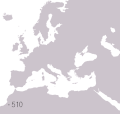Form process
The form process (also form process ) is Roman law the multiple by using, from the actio of the applicant and a possible exceptio (defense) of the defendant method formulas formed ( process program marked) method. The process type is considered a praetoric creation. Initially, it was only applied to complaints from money loans and replaced the procedural form of legis actio per condictionem , which was already known from the early Republican era . They were always fee rights .
Form process ( agere per formulam ) means that the process is determined by a formula given by the magistrate to the judge. The decision should be based on certain words contained in the formula: appointment of judges, dispute program, cause of action, subject of action and conviction.
It is disputed whether the praetor or the parties laid down the trial program in Roman law. From the outward appearance, the formula was probably a certificate .

Development of the Roman types of processes
Historically, the form process was preceded by the legislative action procedure (from lege agere - acting according to fixed formulas that had to be spoken by the parties before the magistrate ). Originally a uniform procedure, according to the source tradition it was characterized in its later phase by a division of the procedural steps. Initially, the process was prepared by the magistrate in the first procedural step ( in iure ) by justifying it with certain words ( certis verbis ) (saying). In the second procedural step, evidence was taken before the judge ( apud iudicem ) and the verdict was pronounced.
According to the Institutiones Gai , the process picture has changed since the Lex Aebutia de formulis in the course of the 2nd / 1st . Century BC The legislative procedure was increasingly superseded by the form process and was replaced by the Augustan leges Iuliae in 17 BC. Abolished (with a few exceptions). From this time onwards , arguments were per concepta verba , that is, per formulas and no longer by means of previously unalterable formulas ; Nevertheless, the difference in content between the two types of process was slight. In addition to the greater freedom of design granted to those involved in the process , the formalism of the archaic proverbial formula procedure, which was bound by sacred tradition, was no longer applicable. During the time of the Principate , there was an innovation insofar as judgments of the iudex became verifiable. In a follow-up procedure ( cognitio ), a civil servant judge was able to overturn the previous decision by virtue of the instance train set up in the new Reich administration, after he had successfully submitted a complaint ( appellatio ) to the Princeps . In enforcement law, the actio iudicati replaced the legis actio per manus iniectionem , but also represented a new process. In this, the enforcement could take place on the person of the debtor, but also on his property.
The form process was superseded by the cognitive process (from cognitio, examination and decision of a legally relevant question by a public official) in the course of the 3rd century AD , and was formally abolished in 342 AD.
Blank in the form process
Blankets are alternate names in the Roman form process:
- AULUS AGERIUS (AA) - Blank for the plaintiff's name
- NUMERIUS NEGIDIUS (NN) - Blank for the defendant's name
- REM - blank for the specific description of the thing
- LUCIUS - example of the name of the judge
Aureus with Emperor Marcus Opellius Macrinus and the Curular Chair
Individual evidence
-
↑ z. B. * exceptio doli : plea of malice. Anyone who acts fraudulently does not deserve legal protection. In the German Civil Code, the exceptio doli is contained in § 242.
- exceptio doli praesentis : defense of present malice. Current malice is malicious, unfaithful behavior during litigation.
- exceptio doli praeteritis : defense of past deceit. Past malice is fraudulent, unfaithful behavior before the process.
- exceptio metus : defense against fear. Objection to claims that have been made under duress.
- ↑ Max Kaser : Roman legal sources and applied legal method. in: Research on Roman Law. Volume 36. Verlag Böhlau, Vienna, Cologne, Graz, 1986. ISBN 3-205-05001-0 . P. 98.
- ↑ Gaii Institutiones 4, 30.
- ↑ Max Kaser , Karl Hackl [edit.]: The Roman civil procedure law . 2., completely revised and exp. Edition / re-edit by Karl Hackl. 2nd Edition. Beck, Munich 1996, ISBN 3-406-40490-1 .
- ↑ Herbert Hausmaninger , Walter Selb : Römisches Privatrecht , Böhlau, Vienna 1981 (9th edition 2001) (Böhlau-Studien-Bücher) ISBN 3-205-07171-9 , p. 374.
literature
- Herbert Hausmaninger , Walter Selb : Römisches Privatrecht , Böhlau, Vienna 1981 (9th edition 2001) (Böhlau-Studien-Bücher) ISBN 3-205-07171-9 , pp. 374–386.
- Max Kaser , Karl Hackl [edit.]: Roman civil procedure law . 2., completely revised and exp. Edition / re-edit by Karl Hackl. 2nd Edition. Beck, Munich 1996, ISBN 3-406-40490-1 , p. 712 .
- Max Kaser, Rolf Knütel [edit.]: Roman private law: a study book . Continued by Rolf Knütel. 19th edition. Beck, Munich 2008, ISBN 978-3-406-57623-2 , pp. 464 .
- Richard Schott: Roman civil process and modern process science : Disputes from the form process , Scienta, Aalen 1985, ISBN 3-511-09187-X .
Web links
- Search for form process in the German Digital Library
- Search for the form process in the SPK digital portal of the Prussian Cultural Heritage Foundation
- limited preview in Google Book search
- Prof. Dr. Wolfgang Ernst, University of Zurich, Institute of Law, Roman Legal History, examples of legal formulas in the form process (PDF; 15 kB)


